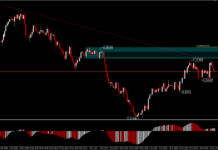- Unemployment Rate (JPY, GMT 23:30) – The Japanese unemployment rate for March is seen higher at 2.5% from 2.4% last month.
Tuesday – 28 April 2020
- Interest Rate Decision & Press Conference (JPY, GMT 03:00 & 06:00) – The BoJ meets for a shortened one-day gathering. It’s unlikely that this would drive the Yen lower, at least in a sustained way, while global markets remain in a cautious state with regard to the global lockdowns caused by the coronavirus pandemic.The bank is expected to keep rates unchanged, while we might see further clarity on the unlimited government bond purchases story (the current JGB limit for the central bank is 80 tln per year) which was reported last week by the Nikkei newspaper. The Nikkei story also reported that the central bank may also double purchase targets for commercial paper and corporate bonds. Further clarity is needed as the BoJ has been meeting the 0% target without the need for unlimited JGB purchases.
- Consumer Confidence (USD, GMT 14:00) – Consumer confidence is expected to fall to a 4-year low of 100.0 in April from a 3-year low of 120.0 in March. All of the available confidence measures were oscillating near historic highs before being crushed by COVID-19, and even with big drop-backs, it’s remarkable how firm the consumer measures have stayed relative to prior recessions.
Wednesday – 29 April 2020
- Consumer Price Index and Core (AUD, GMT 01:30) – The Q1 CPI should be seen down to 0.2% on a quarterly basis in comparison to the 0.7% growth in Q4 2019. The data could reflect the deflationary aspects from the Saudi-Russia oil price war, as well as some of the effects from the coronavirus and the shutdown measures.
- Harmonized Index of Consumer Prices (EUR, GMT 12:00) – The German HICP preliminary inflation for March is anticipated to decline, at 0.8% y/y from 1.3% y/y.
- Gross Domestic Product (USD, GMT 12:30) – The GDP contraction rate has been forecasted at -4.5% in Q1 and -26% in Q2, incorporating the much bigger drops in some of the March source data, which pulled weakness forward into Q1, alongside a downgrading of the Q2 reopening assumptions for May and June.
- Interest Rate Decision & Press Conference (USD, GMT 18:00) – The Fed cash injections have been significant and have helped limit the liquidity squeeze from late February, early March. There was special emphasis on the quarter-end too, to try to ensure there would be no cash crunch to further destabilize the system. The Fed has been successful in its measures to ease strains so much so that the Fed has been reducing the volume of outright purchases, while demand for repos has been lightening.
Thursday – 30 April 2020
- Unemployment data (EUR, GMT 07:55) – The German unemployment rate s.a. for April is seen higher at 5.2% from 5% last month.
- Gross Domestic Product (EUR, GMT 09:00) – The Eurozone Q1 prel. GDP is anticipated to show a sharp slump to -2.7% y/y and -3.2% q/q, as the fallout from Covid-19 has clearly increased recession risks.
- Consumer Price Index and Core (EUR, GMT 09:00) – The March HICP inflation was confirmed at 0.7% y/y, in line with the preliminary number and down from 1.2% y/y in the previous month. Now April’s prel. number is expected to decline to 0.1% y/y with core at 0.8% y/y from 1% last month.
- Interest Rate Decision & Press Conference (EUR, GMT 11:45 & 12:00) – The ECB officials have already taken substantial steps in the quest to safeguard markets and liquidity provisions as economies face deep recessions this year. Aid measures have been set to drive up deficit and debt levels sharply and the ECB is focused on keeping spreads in, with the PEPP allowing the front loading of asset purchases. At the same time collateral rules have been loosened, Greek bonds are now included in the asset purchase program and fallen angels will continue to be eligible as collateral. Against that background we don’t expect any additional measures at the April 30 meeting, but a firm commitment to safeguard the stability of the Eurozone system and take additional action if necessary.
- Jobless Claims (USD, GMT 12:30)– US initial jobless claims dropped -810k to 4,427k in the week ended April 18 following the -1,378k decline to 5,237k (was 5,245k) in the April 11 week. If the drop in initial weekly claims continues, this could suggest that the worst might be over, and that the fiscal policy measures are having some mitigating effects on job losses.
Friday – 01 May 2020
- LABOR DAY
- ISM Manufacturing (USD, GMT 12:30) – The ISM index is expected to fall to 36.0 in April from 49.1 in March, compared to a 14-year high of 60.8 in August of 2018 and recession-low of 34.5 in December of 2008. The available April producer sentiment reports have documented a huge hit to factories from mandatory closures, on top of the demand hit initially associated with the pandemic, and the oil price plunge with the OPEC price war.
Click here to access the HotForex Economic Calendar
Andria Pichidi
Market Analyst
Disclaimer: This material is provided as a general marketing communication for information purposes only and does not constitute an independent investment research. Nothing in this communication contains, or should be considered as containing, an investment advice or an investment recommendation or a solicitation for the purpose of buying or selling of any financial instrument. All information provided is gathered from reputable sources and any information containing an indication of past performance is not a guarantee or reliable indicator of future performance. Users acknowledge that any investment in Leveraged Products is characterized by a certain degree of uncertainty and that any investment of this nature involves a high level of risk for which the users are solely responsible and liable. We assume no liability for any loss arising from any investment made based on the information provided in this communication. This communication must not be reproduced or further distributed without our prior written permission.



















